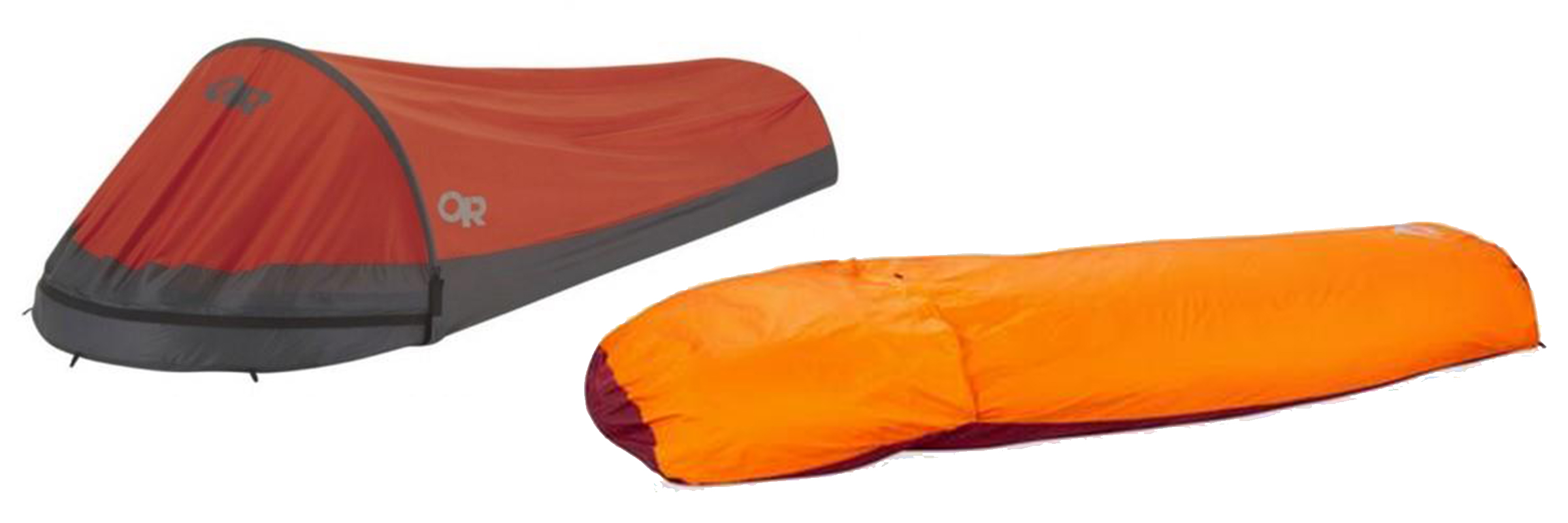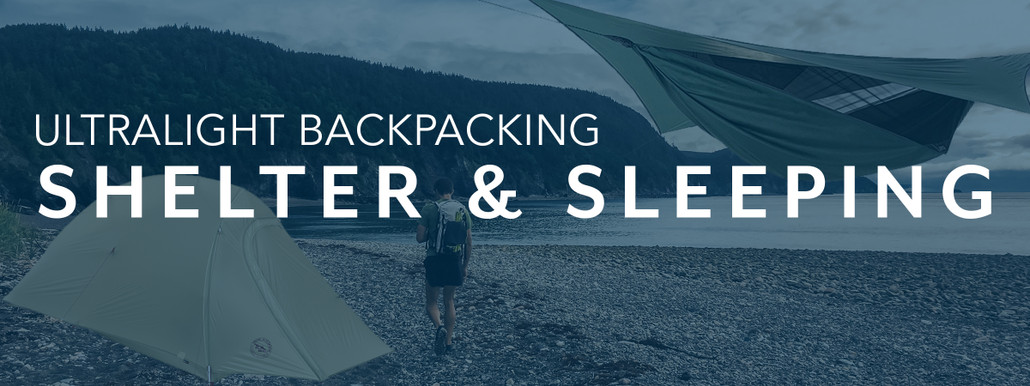Ultralight Backpacking: Shelter and Sleeping
Posted by Bryan on 2020 May 4th
This is merely one section of many on Ultralight Backpacking. Refer to this post for other categories.
SHELTER
There are 4 main types of shelter for all backpackers and all have lightweight versions. Tents, tarps, hammocks and bivies.

TENTS
Tents are the classic that everyone is familiar with. For UB, they are made quite light. I'm calling the ultralight tent weight at 2 lbs (907g) and under. When looking at these tents, I wouldn't go below a 20D floor fabric weight or a 10D fly weight. They come lighter, but you'll have to experiment for the balance point of durability and light weight. Dyneema however should be considered for a shelter material as it is the strongest manmade fiber, and inherently UV resistant, very durable and lighter weight than any other fabric; and it’s waterproof.
Big Agnes makes the lightest tents out there hands down. They even have some super crazy light and expensive carbon and dyneema "concept" tents that are really pushing boundaries. They are interesting to checkout but for practicality and brevity, I won't go into those here. The Big Agnes Fly Creek range has several lightness levels.
The Fly Creek Platinum 2 is a good balance between durability and lightness (above). I find that if you want to go solo, getting a 2-person ultralight (UL) will offer much needed space without a great deal of additional weight. It also gives you the option of going with two people, thus splitting up the weight although it will be a bit more cramped. UL tents as a rule are not very spacious but for UB shelter options, they offer the most coverage. This example is 1 lb, 10 oz. (737g) and quite weatherproof. MSR also makes some light ones like the Freelight 2 but it is on the heavy side. Virtually all UL tents these days have a fast and light set up option that allows you to pitch the fly over the footprint without the tent body. This saves almost half the weight but obviously shouldn't be tried where the bugs are plentiful. Any UL tent should have a footprint with it to increase durability of the floor. Doggy friends are not recommended for any UL tent as their claws will tear it up.
PROS
- Most coverage for UL shelter options
- Great ventilation
- Versatility of 1 or 2 people (if you get a 2 person).
- Rain proof
- Easy to set up anywhere.
- Multiple set up options
CONS
- Not great in storms or high winds.
- On the heavier side of UL setups.

TARPS
Tarps are a super light form of minimalist shelter that should be considered for every UB set up and are usually under 1 lb (454g). Most can be set up with out hiking poles provided there are enough trees around, but poles will give you more options. All UL tarps these days have multiple set up configurations and tie off options for offering more space, headroom or more weather protection. Big Agnes and MSR make some decent ones and there are several cottage manufacturers that make high end dyneema tarps. Insects would need to be considered here as well though. Shown below is the Big Agnes Onyx UL tarp.
PROS
- Super light < 1 lb (454g)
- Variable setups
- Packs very small
- Perfect for dry environments
CONS
- Not great in wind and rain.
- Can be fussy to set up.
- Needs trees or trekking poles.

HAMMOCKS
Hammocks are relatively new to the UB world. Most systems come with options for bug nets, rain flies, and even winter under quilts. Since there are no poles, the packed size can be quite small which, along with weight, is a big consideration for any UB smarties. They are weatherproof too. The Eagle Nest Outfitters (ENO) hammocks have a nice modular system shown with hammock, fly, suspension system and bug net.
Hennessy Hammocks come already to go. If you are in an area with trees, they are straight forward to set up. Most systems have some combination of sewn loops and tie-offs that make set up quick.
PROS
- No poles
- Packs small
- Very weatherproof
- Multiple set up options depending on brand
CONS
- Need trees
- Not comfortable for everyone.
- On the heavier end of the UL set up.
- Must be nimble to get in and out.

BIVIES
Bivies are another option for the minimalist wanting the ultimate in versatility and lightweight. Some are more weatherproof than others, but they are generally under 20 oz (567g). The very lightest ones can be used as an emergency shelter and are not much more than an emergency space bag. The more robust ones offer a Gore-Tex shell and have decent venting. The Outdoor Research (OR) Helium Bivy (below) is just over 1 lb (463g) and rated the best overall bivy on Outdoor Gear Lab.
The MSR Pro Bivy, above is a more minimalist version that packs much smaller and great if you are willing to suffer a little. It is only12 oz. (340g). Many manufacturers make similar bag style bivies.
PROS
- You can put them anywhere
- Very light and small pack size
- Great for emergencies
CONS
- Can be leaky
- Condensation can be a problem
- No room, can be claustrophobic
SLEEPING BAGS
Down is most often considered when going lightweight because it is way lighter than synthetic and compresses much more. Especially when you have a higher loft. Down is rated on "poofiness" and lightness by its loft. More specifically, the number is how many cubic inches 1 oz of down takes up. A 600-loft rating is heavier while a 950 rating is very light and poufy. The higher the rating, the more it will compress and the warmer it is per ounce. Since down looses its ability to insulate when wet, it isn't great for excessively wet areas or weather. It can be done though; you just need to be careful. If you do take down on your UL mission, be sure to get a waterproof, seam sealed compression sack dedicated for your sleeping bag. I've had good luck with my down quilt in 5 days of heavy rain on a trip in the Scottish Highlands. My clothes and quilt stayed dry the whole time. Because down is so much lighter and compressible, most folks take the risk when going light. When going synthetic, try to keep the temperature rating above 10 C. These warmer weather bags are quite light and compact decently for synthetics. The lower the temperature rating for synthetics bags, the bigger and heavier they will be. These days there are two kinds to consider for UB: the mummy and the quilt.
MUMMY
The mummy is the classic style that fits close to the body, has a full or 3/4 zip and a built-in hood that closes in around your face for cold nights. Warmer as a stand-alone piece of gear, but heavier. The Sea to Summit Spark series and the Mountain Hardware Ghost Whisperer are great options.

QUILTS
The Sea to Summit Ember quilts are a classic example with a variety of temperature ratings. As you can kind of see from the picture below, they are meant to be like a blanket or duvet with a closed in footbox. Some have wee bungees to help hold it on the sleeping pad. They are open about 3/4 of the way down. Without a zipper or hood, you can save a ton of grams. The idea is that you will probably have a hat, Buff or hooded puffy with you to wear if you get a little chilly. They are much lighter but can be drafty.
SLEEPING PADS
Thermarest has been making camping air mattresses since 1972. They really know what they are doing and offer some very lightweight and durable options that are reasonably comfortable as well. There are two types, Inflatable and Closed cell foam. Both styles come in long, regular and 3/4 length.

INFLATABLE
These are the lightest and smallest by far. The Thermarest Uberlite weighs only 8.8 oz (250g) and rolls up smaller than a Nalgene bottle.
You must blow the whole thing up all by yourself (your friends will be impressed) and they are quite comfortable. You must take extra care with them as they can obviously get a puncture or leak. Over the years, different models of Thermarest mattresses have come with a repair kit. If yours doesn't come with one, you should be sure to have one in your kit.
PROS
- Smallest and lightest out there.
- Full coverage ones are comfy.
- Easy to wipe off if wet.
CONS
- Not as durable

CLOSED CELL FOAM
Closed cell foam is the most durable for sure as they obviously can't pop.
The one that seems to be the most popular with UL wilderness campers and through hikers is the Thermarest Z Sol. This folding egg carton patterned style is fairly comfy.
PROS
- Super durable, worry free
CONS
- Big
- Most carry it on the outside of their pack
- Hard to dry in wet weather.
- Heavier

